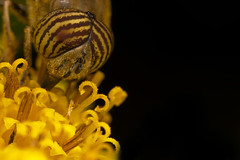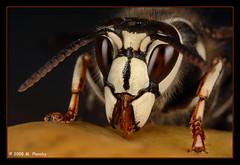Don’t tell the Mrs., but I frequently bait the window sill in the living room with honey. I do it because I know that a lot of insets are attracted to that window due to the amount of sunlight that it gets. I also do it because the window sills in our house are white, and they make the perfect reflector for the flash. Knowing that I’d get a lot of reflected light played a big part in where I placed the area of sharp focus in the next scene…

Link to a larger version -click on the image to make it expand.
I have one of the MT-24EX’s flash heads at the 11 O’clock position and the other at the 2 O’clock position (relative to me) so that I can get the light to wrap around the insect, but at the same time it’s not dead even on both sides –the critter looks 3D and not flat. But notice the area directly under the leading eye –there’s quite a bit of light there, maybe one stop less than the top and the right side of the eye. That’s because the window sill is acting as a reflector. I knew that the bottom of the eye would be well lit, so it needed to be in focus. I also knew that the bubble would also get the same light, and I wanted to make sure that I got all of the bubble and the fly’s mouth parts in focus. So I placed my depth as far back as I could and still get some detail in the leading edge of that eye. At four times life size and F8 I probably have about 1mm of depth to play with and I had to decide what to keep and what to toss out…
There are some hairs on the fly’s face close to the mouth that I could not get into the shot –just not enough depth. But no one who saw that first photo noticed –if they did then they didn’t mention it. Why? Easy –your eyes go right to the fly’s eye, then to the bubble, and then to the rest of the image. You’ll go straight to the eyes of every creature that you see due to a subconscious “fight or flight” reflex: “Is this something that I can kill or do I need to run?”. You then look at the bubble because it’s so prominent and because of the pattern of the mouth parts. The rest of the photo is immaterial…
In this next shot I have the same problem; the window sill is going to light up the underside of the eye. The bubble is smaller now, but the mouth parts are extended; the fly is drawing the bubble in because it’s trying to get away from me and the camera. So I have to pull the area of sharp focus a little closer to me to keep the bubble sharp. Remember those facial hairs that I didn’t get in the first photo, and that you didn’t notice? Here they are:

Link to a larger version -click on the image to make it expand.
The downside to the second shot is that the top of the leading eye is out of focus, just not enough depth at F8 to get it all in. I didn’t think to go to F11, and looking back I didn’t really have time either. The entire scene was one fleeting moment and sometimes you just have to make the best of it…
Footnote: Focus stacking would not have been possible for two reasons. The obvious one is that the fly was drawing the bubble in, so no two frames would have been exactly the same. The other is that every time the flash fired the fly jumped –I had to reframe and refocus for every shot.



